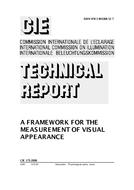Description
Visual appearance can be one of the most critical parameters affecting customer choice and it needs, therefore, to be quantifiable to ensure uniformity and reproducibility. A starting point in assessing the appearance of a consumer product might be the measurement of its colour. A description of its total appearance, however, cannot be achieved by the definition of colour alone; other attributes of the material from which it is fabricated contribute to the overall appearance.
Starting from a definition of soft metrology and a description of measurement scales, this report describes a framework on which a set of measurements could be made to provide correlates of visual appearance. It will be shown that the interactions between the various components of the framework are complex, that physical parameters relating to objects are influenced, at the perception stage, by the physiological response of the human visual system and, in addition by the psychological aspects of human learning, pattern, culture and tradition.
The result might be to conclude that an attempt to measure appearance may be too bold a step to take. Thus, a sub-framework is considered in terms of what can now be measured, and what might be measured after further investigation and research. By dealing with the optical properties of materials it is seen that there are, perhaps, four headings under which possible measures might be made: colour, gloss, translucency and texture. It is recognised that these measures are not necessarily independent; colour may influence gloss, colour will certainly influence translucency, and texture is probably a function of all three of the other measures.
Colour measurement, colorimetry, is based on the measurement of spectral reflectance, and is an established science that is possible using commercial instrumentation available at reasonable cost. Two shortcomings are identified. First, there are a number of modern materials where colour measurements made using a single pair of illumination/viewing angles is not sufficient to describe the perceived colorimetric effect. Thus, measurement at more illumination/viewing angle combinations is required. Second, the traditional, CIE recommended colorimetric parameters, while providing correlates of visual percepts, are not able to predict the absolute appearance of a coloured sample: colour appearance models are now able to do this.
The measurement of gloss is an established methodology but there is some doubt as to the scientific basis for making the measurements using the present method and attempts are being made to define alternative approaches. The extension of gloss measurement, which is essentially a measurement made at aspecific angle depending on the apparent gloss of the sample, to investigate the shape of the gloss peak, should provide more information.
Translucency is a subjective term that relates to a scale of values going from total opacity to total transparency. This whole subject area needs investigation to find a rigorous measurement solution that will probably be industry specific.
Texture is a harder variable to measure. The advent of digital imaging systems makes the acquisition of images of materials relatively easy, assuming due consideration is given to the resolution of the image capturing device, be it a camera or a scanner.
Characterising these images to give accurate CIE based colorimetry is now possible and the application of suitable analysis software should be able to provide measurement scales that relate to the perceived texture. The idea of establishing a series of 'standard' textures has been suggested.
The report is written in English, with a short summary in French and German.
Product Details
- Published:
- 12/01/2006
- ISBN(s):
- 9783901906527
- Number of Pages:
- 92
- File Size:
- 1 file , 1.3 MB
